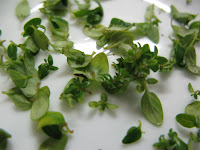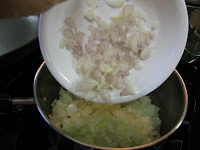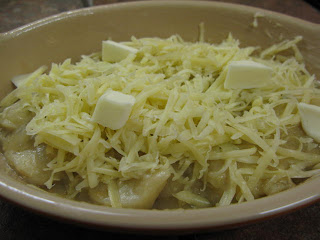 Bonjour a tous! Welcome again to Cépage et Cuisine, Mary’s
and Brian’s wine and food blog. Today we’re
describing a dish we love and, once again, giving credit where credit is due,
it is from Julia Child’s Mastering the
Art of French Cooking. The dish is
scallops gratinéed with wine, garlic,
and herbs.
Bonjour a tous! Welcome again to Cépage et Cuisine, Mary’s
and Brian’s wine and food blog. Today we’re
describing a dish we love and, once again, giving credit where credit is due,
it is from Julia Child’s Mastering the
Art of French Cooking. The dish is
scallops gratinéed with wine, garlic,
and herbs.
Along with our love of French food, wine, and culture, Julia’s
book has transformed our hobby, taking our enjoyment of fine wine and food to a
higher level (a blog post for another day).
This scallop dish is easy, delicious, doesn’t take too long, and is
terrific with a lovely white Burgundy.
 Here are our scallop friends. They can be kind of confusing…sea scallops,
bay scallops, jumbo scallops, on and on.
We used sea scallops for this recipe, which are larger than bay scallops
and better for searing. Scallops are mollusks,
found all around the world and consumed in many different cultures. Something we’re trying to eliminate in
preparation is the grit that is sometimes found in them. Apparently, the problem is that most scallops
are harvested by dredging the ocean floor, which drives grit into the
shell. Diver scallops, which are
harvested by hand, have much less grit.
Rinsing and soaking the scallop helps cut down the grit, but we still
notice it sometimes.
Here are our scallop friends. They can be kind of confusing…sea scallops,
bay scallops, jumbo scallops, on and on.
We used sea scallops for this recipe, which are larger than bay scallops
and better for searing. Scallops are mollusks,
found all around the world and consumed in many different cultures. Something we’re trying to eliminate in
preparation is the grit that is sometimes found in them. Apparently, the problem is that most scallops
are harvested by dredging the ocean floor, which drives grit into the
shell. Diver scallops, which are
harvested by hand, have much less grit.
Rinsing and soaking the scallop helps cut down the grit, but we still
notice it sometimes. Also, scallops have a tough piece called the catch muscle, the part that
attaches to the inside of the shell.
That needs to be removed before cooking. You can see it looks like a tag attached to the scallop.
Also, scallops have a tough piece called the catch muscle, the part that
attaches to the inside of the shell.
That needs to be removed before cooking. You can see it looks like a tag attached to the scallop.
It usually peels right off by hand and is thrown away. The scallops are then patted dry and ready
for cooking.
Here’s Mary to talk about preparing the dish.
Here are all my ingredients…the scallops, of course, onion,
shallot, garlic, fresh thyme, bay leaf, a good Swiss cheese like Emmental, my
faithful La Vieille Ferme white wine, butter, olive oil, salt, pepper, and
flour.
I chopped the onion, shallot, and garlic and started a sauté in a little
butter, first with the onion, then adding the shallot, then the garlic.
 While that was cooking, I sliced the scallops crossways or horizontally,
about 3 slices for each scallop.
While that was cooking, I sliced the scallops crossways or horizontally,
about 3 slices for each scallop.
I dredged the slices in flour, shaking off the excess, and
they were ready to go.
In a different pan, the scallops went into hot melted butter
and the olive oil, turning to get a nice pretty browning on each side. I had to be careful with this because they
cook very quickly and I didn’t want to overcook them. They only need a couple of minutes on each
side.
Then I added about a half cup of the wine and a little
water. That cooled things down. I added the onion-shallot-garlic mixture and
the thyme and covered the pan to simmer for a few minutes. That helps all the flavors to integrate.
I uncovered the pan and simmered the mixture just long
enough to reduce it and thicken it a little.
It smelled so good!
Here are my oval dishes, all buttered and ready to go. I love these dishes. They’re perfect for a single portion dish
like this one or fish or potatoes.
Similar dishes are readily available in many sizes. We got these at Sur la Table.
I spooned the scallops and sauce into the ovals, then topped
them with the grated Emmental and dots of butter.
The dishes went into the oven under the broiler to heat the
mixture through and brown the cheese.
This photo is a little fuzzy, but you can see how it looks right out of
the oven. Something we learned recently
is the word gratin actually means a
browned crust. Americans are used to the
term, au gratin, just meaning “with
cheese,” but the correct meaning is the browned crust. Potatoes au gratin have that great crust.
 I plated the dish over a bed of whole grain linguini, keeping the gratin on top. The pasta isn’t part of Julia’s recipe, but
it wouldn’t be unusual in Provence.
I plated the dish over a bed of whole grain linguini, keeping the gratin on top. The pasta isn’t part of Julia’s recipe, but
it wouldn’t be unusual in Provence.
Paired with a nice salad with olives and fresh sliced
tomatoes, it was a wonderful dinner.
Delicious! Here’s Brian to talk about the wine, which was amazing
with the scallops.
We have had the scallop dish a few times, so I knew it was
going to be fantastic. Julia’s recipe in
Mastering calls for chilled rosé or
white wine of Provence, like the La Vieille Ferme we used for cooking, but I
went all out and selected Corton Charlemagne by Vincent Girardin. This is a Grand Cru from the famed hill of
Corton in the Côte de Beaune, among the grandest and most thrilling Chardonnays
in the world. I wrote about the
fascinating history of Corton Charlemagne in our trip blog back in May. Here is a photo of the vineyard.
Grand Cru wines are complex, usually fuller
in body and richness, but still elegant, generally just more interesting than
most wines. They evolve in the glass,
revealing new aromas and flavors as the meal progresses. They need a little time, both in the bottle
before opening, and in the glass over the course of a leisurely dinner. They really require something of the consumer,
a little thought and examination of the wine, and not quaffed down too quickly. They are not everyday wines. Open one of these with someone you love or a
very special guest who understands and appreciates rare and wonderful wines. That’s what I had in mind for this wonderful
dinner and my wonderful wife, Mary. Here
are my notes on the wine.
Domaine Vincent
Girardin Corton Charlemagne 2001. This
is a stunning Chardonnay. Golden in
color, the aromas were complex with lemon, tree fruit, and a fresh, minerally
scent. The palate was full-bodied,
creamy, with good acidity, and fresh flavors of lemon, peach, apple, a little
hazelnut quality, but not at all oaky. With
time in the glass, new layers were revealed, caramel and butterscotch, and the
peach notes more noticeable. Exquisitely
well balanced, perfect for a seamless pairing with a dinner of scallops,
complex, the finish sails on and on, 13.5% alcohol. We grieved when the bottle was empty. The pedigree of Corton Charlemagne is obvious. We paid $65 for this wine, which is a
bargain. It would easily cost over $200
in a restaurant.
Here’s a delicious dinner.
Come on over and join us!
Vin d’amis, that’s
our post for today. We hope you enjoyed
it. We love the wine, the food, and we
enjoy sharing it with you. Keep checking
back for more adventures about wine and food at Cépage et Cuisine. Don’t forget, you can follow our nightly
tweets on Twitter at www.twitter.com/cepageetcuisine.
Cheers,
Mary♥Brian


























YUM! I think I just gained 10 lbs reading that. Looks delicious!
ReplyDelete